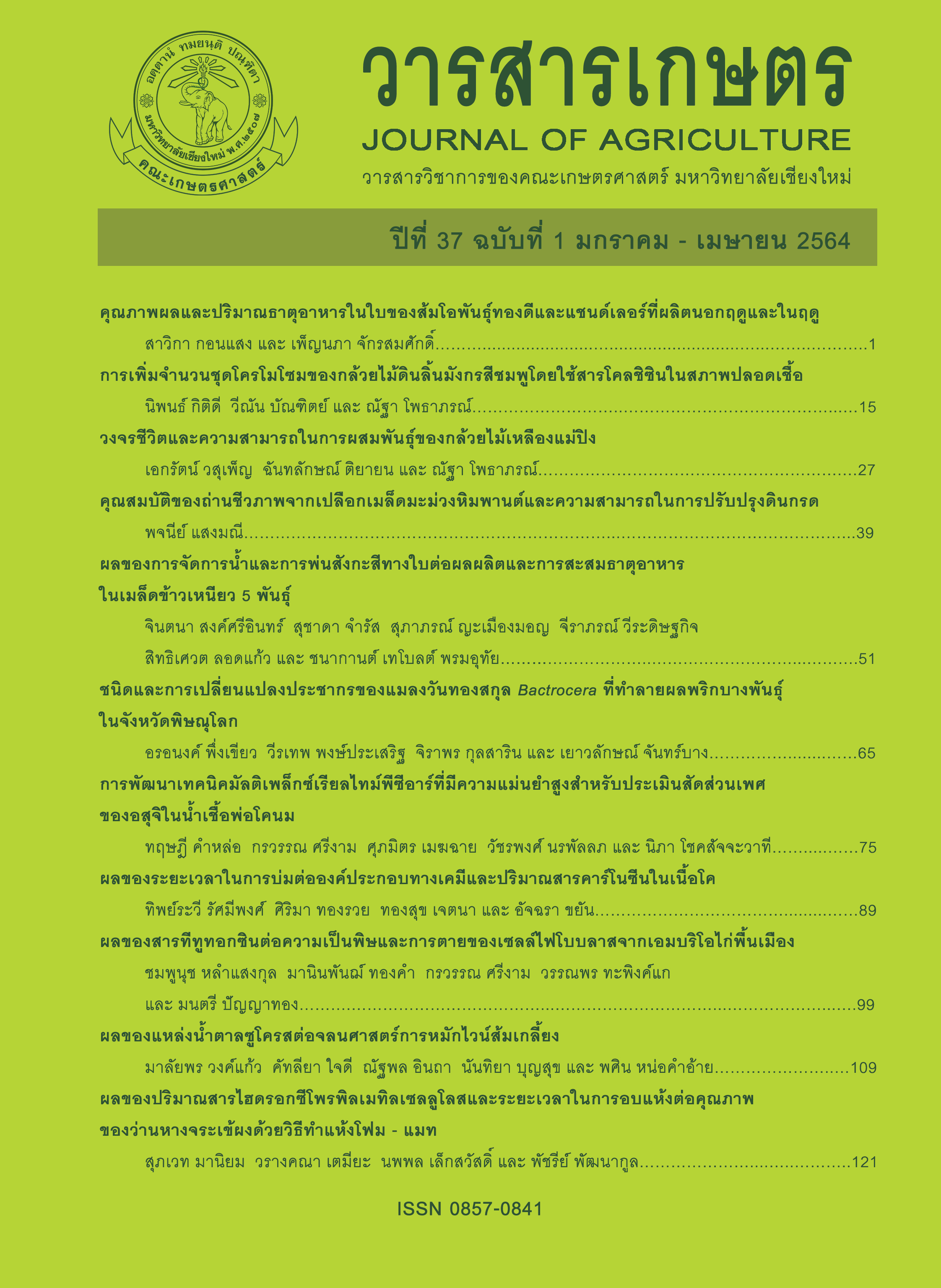วงจรชีวิตและความสามารถในการผสมพันธุ์ของกล้วยไม้เหลืองแม่ปิง
Main Article Content
บทคัดย่อ
เหลืองแม่ปิงเป็นกล้วยไม้ที่พบได้ที่อำเภอเวียงป่าเป้า จังหวัดเชียงราย มีช่อดอกสูง 124 ± 32.5 เซนติเมตร มีดอกย่อย 35 ± 12 ดอกต่อช่อ ดอกบานช่วงกลางเดือนพฤษภาคมถึงกลางเดือนมิถุนายน ปัจจุบันพบได้ค่อนข้างน้อย จึงได้ศึกษาความสามารถในการผสมตัวเองและผสมข้ามของ E. flava กับกล้วยไม้ 4 ชนิด ได้แก่ E. dufossei, E. macrobulbon, E. pauciflora และ E. spectabilis และกล้วยไม้ต่างสกุล 2 สกุล ได้แก่ Cymbidium aloifolium และ Geodorum citrinum พบว่า E. flava สามารถผสมตัวเองได้ 100 % และใช้เป็นแม่พันธุ์ผสมข้ามกับกล้วยไม้บางชนิด ได้แก่ E. dufossei, E. macrobulbon, E. spectabilis, C. aloifolium และ G. citrinum ซึ่งฝักที่เกิดจากการผสมข้ามชนิดติดฝักได้ดีมีจำนวนเมล็ดมาก ส่วนฝักที่เกิดจากการผสมข้ามสกุลติดเมล็ดน้อย จำนวนโครโมโซมเท่ากับ 2n = 54 การทดสอบความมีชีวิตและความงอกของเมล็ดจากฝักอายุ 90, 120, 150, 180 และ 210 วัน พบว่า ความมีชีวิตของเมล็ดเมื่อทดสอบด้วย 1 % TTC เท่ากับ 57.8, 91.3, 89.9, 89.8 และ 98.5 % ตามลำดับ ส่วนความงอกของเมล็ดบนอาหารวุ้นสูตร MS เท่ากับ 8.4, 9.3, 14.1, 26.4 และ 47.5 % ตามลำดับ นอกจากนี้ยังพบว่า เมล็ดอายุน้อยใช้เวลาในการงอกนานกว่าเมล็ดที่อายุมาก
Article Details
เอกสารอ้างอิง
Aoyama, M. 1989. Karyomorphological studies in Cymbidium and its allied genera, Orchidaceae. Bulletin of the Hiroshima Botanical Garden 11: 1-121.
Chayamarit, K., R. Pooma and N. Pattharahirantricin. 2014. A Checklist of Plants in Thailand, Volume I. Office of Natural Resources and Environmental Policy and Planning, Bangkok. 238 p. (in Thai)
Chung, M.Y. and M.G. Chung. 2003. The breeding systems of Cremastra appendiculata and Cymbidium goeringii: high levels of annual fruit failure in two self-compatible orchids. Annales Botanici Fennici 40: 81-85.
De, L.C., P. Pathak, A.N. Rao and P.K. Rajeevan. 2014. Commercial Orchids. De Gruyter Open Ltd., Warsaw. 322 p.
Deng, X., R. Mo, Y. Luo and M. Lin. 2009. The karyotype analysis of Eulophia flava. Journal of Fujian Forestry Science and Technology 4: 80-83.
Department of International Trade Promotion. 2019. Orchid fact sheet. (Online). Available: https://www.ditp.go.th/contents_attach/539560/539560.pdf (October 27, 2019). (in Thai)
Dressler, R.L. 1993. Phylogeny and Classification of the Orchid Family. Cambridge University Press, Cambridge. 314 p.
Felix, L.P. and M. Guerra. 2000. Cytogenetics and cytotaxonomy of some Brazilian species of Cymbidioid orchids. Genetics and Molecular Biology 23(4): 957-978.
Godo, T., M. Komori, E. Nakaoki, T. Yukawa and K. Miyoshi. 2010. Germination of mature seeds of Calanthe tricarinata Lindl., an endangered terrestrial orchid, by asymbiotic culture in vitro. In Vitro Cellular & Developmental Biology - Plant 46: 323-328.
Inpar, C. and N. Potapohn. 2009. Effects of temperature and storage period on pollinia viability percentage on Dendrobium scabrilingue Lindl., D. anosmum Lindl., D. parishii Rchb. f. and D. peguanum Lindl. Journal of Agriculture 25(2): 101-108. (in Thai)
Kauth, P. J., D. Dutra, T. R. Johnson, S. L. Stewart, M. E. Kane and W. Vendrame. 2008. Techniques and applications of in vitro orchid seed germination. pp. 375-391. In: J. A. T. da Silva (ed.). Floriculture, Ornamental and Plant Biotechnology: Advances and Topical Issues, Volume V. Global Science Books, Ltd., London.
Krasaechai, A. 1996. Flowering Crops Improvement. Faculty of Agriculture, Chiang Mai University, Chiang Mai. 271 p. (in Thai)
Lee, Y., C. Lu, M. Chung, E.C. Yeung and N. Lee. 2007. Developmental changes in endogenous abscisic acid concentrations and asymbiotic seed germination of a terrestrial orchid, Calanthe tricarinata Lindl. Journal of the American Society for Horticultural Science 132(2): 246-252.
Millner, H.J., A.R. McCrea and T.C. Baldwin. 2015. An investigation of self-incompatibility within the genus Restrepia. American Journal of Botany 102(3): 487-494.
Niu, S., J. Huang, Q. Xu, P. Li, H. Yang, Y. Zhang, G. Zhang, L. Chen, Y. Niu, Y. Luo and Z. Liu. 2018. Morphological type identification of self-incompatibility in Dendrobium and its phylogenetic evolution pattern. International Journal of Molecular Sciences 19(9): 2595, doi: 10.3390/ijms19092595.
Pintajam, P., C. Tiyayon and N. Potapohn. 2016. Interspecific and intergeneric crossabilities of Eulophia macrobulbon (Par. & Pchb. f.) Hook. f. and E. spectabilis (Dennst.) Suresh. Journal of Agriculture 32(3): 299-308. (in Thai)
Pintajam, P., W. Bundithya and N. Potapohn. 2018. Intraspecific and interspecific crossability of some Eulophia species. Maejo International Journal of Science and Technology 12(3): 241-250.
Piyatrakul, P. 2004. Factors influencing germination and seedling development of Habenaria rhodocheila Hance. M.S. Thesis. Chiang Mai University, Chiang Mai. 171 p. (in Thai)
Rodjanawijid, S., P. Sornchai, D. Sumrittinun, N. Dechsangkranon, B. Kongsamai and S. Chanprame. 2016. The technique for pollinia separation and pollen germination test for certain Dendrobium cultivars. Agricultural Science Journal 47(3): 305-316. (in Thai)
Rungruang, C. 2001. Population variation of Eulophia flava (Lindl.) Hook.f. in Mae Ping National Park, Lamphun province. M.S. Thesis. Kasetsart University, Bangkok. 78 p. (in Thai)
Thammatha, P., S. Techawongstien and S. Techawongstien. 2016. Appropriate time of pollination on fruit set of pummelo cv. Manee Esan crossed with pummelo cv. Thong Dee. Songklanakarin Journal of Plant Science 3(Suppl. I): M01/31-36. (in Thai)
Thongsan, A. 2008. Characterization and hybridization of Geodorum spp. collected from Khun Mae Kwuang National Reserved Forest. M.S. Thesis. Chiang Mai University, Chiang Mai. 174 p. (in Thai)
van der Cingel, N. A. 2001. An Atlas of Orchid Pollination: America, Africa, Asia and Australia. A. A. Balkema Publishers, Rotterdam. 296 p.
van der Kinderen, G. 1987. Abscisic acid in terrestrial orchid seeds: a possible impact on their germination. Lindleyana 2(2): 84-87.
Yamazaki, J. and K. Miyoshi. 2006. In vitro asymbiotic germination of immature seed and formation of protocorm by Cephalanthera falcata (Orchidaceae). Annals of Botany 98(6): 1197-1206.
Zhang, Y., Z. Zhao and Y. Xue. 2009. Roles of proteolysis in plant self-incompatibility. Annual Review of Plant Biology 60: 21-42.


